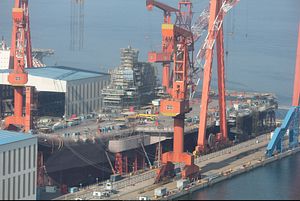The People’s Liberation Army Navy’s (PLAN) first indigenously designed aircraft carrier, the Type 001A Shandong, will reportedly commence mooring trials next month, according to Chinese state-media reports.
Citing Hu Wenming, the general director overseeing construction of the new warship, the People’s Daily Online reports that the “carrier will likely enter mooring trials next month ahead of schedule to test if its equipment is able to meet the requirements for further sea trial.” The Shandong was launched in April by China Shipbuilding Industry Corporation at the Dalian shipyard in Liaoning Province.
“Hu also disclosed that a total of 412 state-owned enterprises, private enterprises, and scientific research institutions in China have contributed to its development, occupying 77.4 percent of the total, which indicates that its construction is the result of national collective efforts,” the People’s Daily Online states.
As The Diplomat reported earlier this week, the new 65,000-ton carrier, an improved variant of the PLAN’s only operational aircraft carrier, the 60,000-ton Type 001 Liaoning — a retrofitted Soviet-era Admiral Kuznetsov-class multirole flattop, could already join the PLAN as early as 2018. It was previously expected that the ship would not be commissioned prior to 2020.
Both the Shandong and its predecessor Liaoning will serve as test platforms for Chinese carrier-based naval aviation and technology demonstrators. “China’s first aircraft carrier, the Liaoning, has been delivered to the Chinese Navy for training and research,” the People’s Daily Online notes.
“China’s second carrier will be based on the Liaoning and will be among the world’s most advanced, further improving China’s research and development of aircraft carriers,” according to Hu. Once inducted, the new carrier will be able to accommodate up to 24 Shenyang J-15 multirole fighter jets, a variant of the fourth-generation Sukhoi Su-33 twin-engines air superiority fighter, as well as up to ten rotary wing aircraft such as Changshe Z-18, Ka-31, or Harbin Z-9 helicopters.
China’s second carrier will not be fitted with a more advanced catapult-assisted launch system found on U.S. carrier, but rather a ski-jump assisted Short Take-Off But Arrested Recovery (STOBAR) launch system, which brings a number of disadvantages as I noted elsewhere:
Given the STOBAR system, aircraft launched from the carrier will also have a more limited operational range due to the fact that they need to expend a considerable amount of fuel during take-off in comparison to aircraft launched with a catapult system as is the case in the U.S. Navy.
In addition, aircraft launched with a STOBAR system usually also carry lighter armament, reducing the ship’s overall combat power. However, there is speculation that the PLAN’s next carrier, dubbed Type 002, will be using more modern catapult technology.
China’s Navy plans to operate up to six carrier strike groups in the coming decades.

































